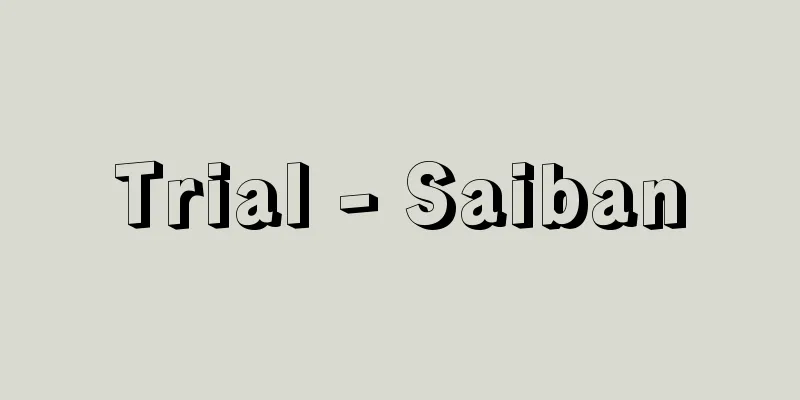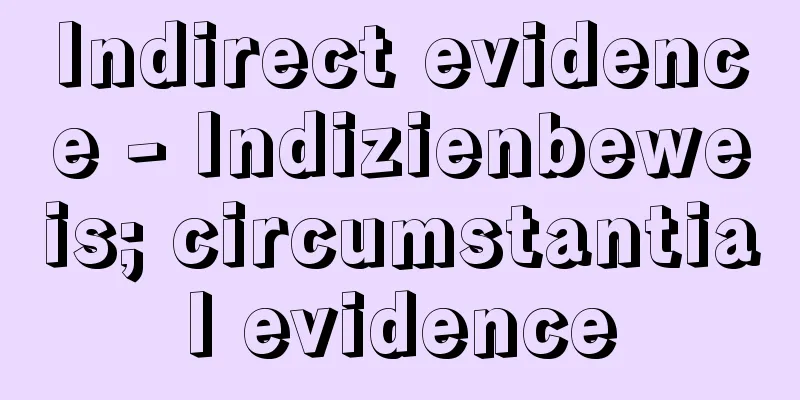Trial - Saiban

|
A judgment is a decision made by a judicial institution (court, presiding judge, commissioned judge, or entrusted judge) in a lawsuit regarding the resolution of the case that it has accepted, or regarding the progress of the proceedings. This decision is not merely a recognition of an object, but should be seen as an expression of intent based on a certain judgment and accompanied by recognition of the outcome, so it can be defined as "a judgment is the expression of intent of a judicial institution in a lawsuit with the aim of producing a certain legal effect." Therefore, a trial is specifically carried out in a specific lawsuit by a judicial institution in accordance with the provisions of law, and is a procedural act that constitutes part of the proceedings in that lawsuit. In modern countries governed by law, all trials are said to be conducted in accordance with objectively established laws. In Japan, too, it is stated that "all judicial power shall be vested in the Supreme Court and in such inferior courts as are established by law" (Article 76, paragraph 1 of the Constitution), and that "All judges shall be independent in the exercise of their conscience and shall be bound only by this Constitution and the law" (same Article, paragraph 3 of the Constitution), and this is considered the fundamental principle of current law. [Takeyoshi Uchida and Tetsuo Kato, May 19, 2016] Types of TrialsThere are two types of trials. One is a substantive trial, which is conducted on the "object of the litigation" (the subject matter of the litigation) in order to resolve the dispute and ultimately protect the rights of the parties involved. The procedure follows the provisions of the Civil Procedure Code, but the content is determined by the application of substantive law (Civil Code, Commercial Code, Criminal Code, etc.). The other is a trial conducted on matters related to the litigation procedure (for example, "trial to transfer a case" under Article 16 of the Civil Procedure Code, or "trial to determine the validity of a witness' refusal to testify" under Article 199 of the same code), which relies solely on the procedural code and has no direct connection to substantive law. Although there are two types of trials, the core of the judicial system is the former, and judicial theory is mainly conducted on substantive trials. In modern jurisprudence, the content of a judgment is discussed in two stages: "fact-finding" and "application of law." In the process of establishing a judgment, the finding of facts takes precedence over the application of law in terms of institutional logic, and is also to a certain extent a practical stage of litigation. In other words, the facts that should be the basis of a judgment are divided into facts that do not require proof and facts that require proof. The court's right to find facts that do not require proof is excluded, whereas the finding of facts that require proof (judgment of truth or falsity) is made by the court's free judgment of impression based on evidence (Article 247 of the Civil Procedure Code, Article 318 of the Criminal Procedure Code). Once a fact is found, the law must be applied to it, and the application of this law belongs to the court's exclusive right (there is a Latin phrase "Jura novit curia," which means "the court knows the law"). Fact finding is the determination of legal facts that should be applied to the legal requirements set forth in the law as a prerequisite for the application of the law to the case in question, and application of the law is the logical operation of applying the specific facts of a particular case to the legal requirements set forth in the law and determining the legal effect in that case. Furthermore, fact finding, which is the basis of a judgment, is not simply the determination of objective facts, but also involves a great deal of legal value judgment, and the application of the law is not only influenced by the fact finding, but also involves issues of abstract legal interpretation. Therefore, fact finding and legal interpretation and application are interrelated and structure the process of a trial and constitute its content. [Takeyoshi Uchida and Tetsuo Kato, May 19, 2016] Theory of the trialAccording to the formal theory of conceptual jurisprudence, a trial is a logical operation that applies the specific facts recognized by the court to the legal requirements set out in the law and determines the legal effect in the case. This logical operation process is applied to formal logic (hypothetical syllogism), so the logical structure is as follows: In other words, when a trial takes the form of a syllogism, for example, if the major premise is "A person who violates the rights of others is liable to pay damages" (law) and the minor premise is "A violated the rights of others" (fact), the resulting proposition is "A is liable to pay damages," and if the major premise is "A person who kills others is sentenced to death" (law) and the minor premise is "B killed someone" (fact), the conclusion is "B is sentenced to death." All modern trials take this logical form to ensure fairness. This is because in modern society, the law that should be the major premise, that is, the substantive law that should be the standard for judgment in trials, is required to be in a state that anyone can know and to be objective, and the same is true for the procedural law that regulates the procedure. The facts that serve as the minor premise are also recognized as being at the limit of what humans can perceive at the time of the trial. Furthermore, the qualifications of the judges who make the decisions are stipulated in Article 41 and subsequent articles of the Court Act, and there is a sense of trust that they are people who have a certain level of legal knowledge and experience and have been trained to be judges. This is probably because people believe that the results derived from the combination of these factors are always consistent. Turning the other way around, because there is a demand for stability and averageness, there is no need in the modern judicial system for so-called master judges who are particularly superior to ordinary judges. This is because it is believed that objectivity is already guaranteed. However, it is the judge, a natural person, who makes a decision by such logical operations. Moreover, trials are carried out on the basis that the judge and the person being judged are recognized as human beings of the same nature, and this is a system that is recognized by the nation and society. Therefore, as already mentioned, when interpreting and applying the law to apply concrete facts in trials, it is unavoidable that the judge, as a human being with emotions, will be influenced by various factors arising from his or her personality, thoughts, environment, etc. in the process of forming a judgment. This should be kept in mind. However, this does not mean that trials are not judgments that apply the law. As long as the law exists, trials are given as much rationality, objectivity, and uniformity as possible, and also have the meaning of giving the parties and others the expectation that the outcome of the trial can be predicted to a certain extent. Therefore, trials need to be objective and persuasive enough to convince the parties of the outcome. For this reason, judgments are required to always include reasons (Civil Procedure Code, Article 253, Paragraph 1, Item 3, Criminal Procedure Code, Article 44, Paragraph 1). Therefore, a trial can be said to be a decision that reaches a logical and objective conclusion. It is noteworthy that psychological analysis of the trial process and sociolegal research are becoming more and more popular in Japan as well. [Takeyoshi Uchida and Tetsuo Kato, May 19, 2016] Differences between civil and criminal proceedingsIn civil litigation, the object of litigation is the right of a private individual, and under substantive law, it is something that a private individual can dispose of. In contrast, in criminal litigation, the object is a crime, and not only the parties involved but also society has an interest in determining whether or not it exists, so it cannot be left to the parties to dispose of it. Therefore, in criminal litigation, the principle of discovery of substantive truth is emphasized more than in civil litigation, and therefore the principle of official authority is inevitably required. However, this principle of official authority cannot be absolute. This is because the current criminal litigation has a two-party system (a conflict between the plaintiff, the prosecutor, and the defendant) structure, with the main focus on protecting the interests of the defendant, and is limited by the requirement to protect the basic human rights of individuals, not limited to the defendant, along with the public welfare. In contrast, the principle of official authority in civil litigation is adopted in personal affairs litigation (Article 20 of the Personal Affairs Litigation Act) and non-contentious cases (Article 49 of the Non-Contentious Cases Procedure Act), which are of great public interest, but this is supplementary, and the foundation of civil litigation is the principle of official authority. Therefore, the principle of official procedure there is mainly manifested in the form of official proceedings principle (the principle that recognizes the court's initiative in the progress of litigation proceedings). [Takeyoshi Uchida and Tetsuo Kato, May 19, 2016] Public participation in trialsIn Japan, criminal trials have long been conducted by professional judges. However, looking at the world, there are many countries in which citizens participate in criminal trials in some form. The most well-known form of citizen participation in trials is the jury trial. It is adopted in common law countries such as the UK, the US, and Canada. A jury trial is a system in which a jury of usually 12 people selected from the public decides on the guilt or innocence of the defendant independently of the judge. In other words, after the questioning of witnesses in the trial is finished, the presiding judge explains the issues for deliberation, and the jurors move to a separate room to deliberate. No one other than the jurors is allowed in the deliberation room. In principle, a unanimous verdict is required for a guilty verdict. If a unanimous conclusion cannot be reached, the jury selection process will be started again. The result of the verdict is reported in court, and if the defendant is guilty, the defendant is told that he is guilty, and if he is not guilty, the defendant is told that he is not guilty. If he is guilty, the judge determines the sentence. Japan also implemented the jury system from 1928 (Showa 3) to 1943. However, the Japanese jury system was not the same as the jury system in that the jurors' recommendations were not binding on the court and if the court deemed the recommendation to be unreasonable it could select a new juror. In continental Europe, such as Germany and France, the jury system is used. In the jury system, a professional judge and lay jury members form a single judicial body, and both have the same authority to conduct trials. The composition of the jury varies from country to country; for example, Germany has three judges and two jury members, France has three judges and nine jury members, and Italy has two judges and six jury members. The jury members have the same status as the judges, and have the same voting power as the judges in both fact-finding and sentencing. However, for example, in Germany, verdicts are decided by a two-thirds majority (so-called absolute majority), so a guilty verdict cannot be determined by only three judges. In Japan, the "Law on Criminal Trials with Lay Judges" (Law No. 63 of 16) was enacted on May 28, 2004, allowing citizens to participate in criminal trials. This law came into effect on May 21, 2009. In principle, lay judge trials in Japan are composed of three judges and six lay judges. However, if there is no dispute about the case, a simple collegial body of one judge and four lay judges is also possible. Lay judges are randomly selected from among citizens for each case, just like in the jury system, but the authority of lay judges is equal to that of judges, just like in the lay judge system, and extends to fact-finding, application of laws and regulations, and sentencing. Lay judges and judges also have equal voting power, but in order to convict a defendant, a special majority system is adopted, in which the majority opinion, including the opinions of both judges and lay judges, is required. Therefore, the majority of five people must include both a judge and a lay judge. A defendant cannot be convicted by a majority of five lay judges alone. In this way, Japan's lay judge system contains elements of both the jury system and the lay judge system, but in that a single panel is made up of both citizen and professional judges, it can be said to be closer to the lay judge system in Europe. [Moriichi Taguchi] Court History / EuropeIn ancient European trials, there was no clear distinction between civil and criminal proceedings as we have today. In the pursuit of wrongdoing, self-help was initially used, followed by the taking of revenge and sometimes even war between clans. Eventually, methods such as handing over the perpetrator to the victim and leaving them to deal with the crime, or retaliation (talio) were also used, and with the appearance of currency, responsibility began to be paid for with money. However, for serious crimes such as murder or crimes that had a significant impact on the existence of the state (such as treason), the state power itself took control of the right to punish, and state members were more or less involved in these crimes (popular trials), and the impeachment system (a three-sided structure of the accuser, the accused, and the judge) was adopted. In ancient Athens, trials were held with a list of 6,000 judges selected by lot from among those eligible to attend the assembly, with the number of judges attending varying for each case. A magistrate presided over the trial, and after evidence was examined and oral arguments were held, the judges voted to determine guilt or innocence, and a verdict was handed down. There was no system of appeal. In ancient Rome, judicial power was held by the king during the monarchy, but was transferred to the praetor during the republican period. The king and the praetor exercised disciplinary power against citizens for misconduct. In 367 BC, a new praetor was established, who was responsible for cases between citizens. The traditional method of litigation between citizens was called a legal suit, and consisted of two steps: the court procedure and the tribunal procedure. The plaintiff brought the defendant before the praetor (courtroom), and when the praetor approved the lawsuit, the plaintiff made a bet, clarified the issues in the case, and selected a tribunal from among the citizens and agreed to by both the plaintiff and the defendant (court procedure). Then, three days later, both parties appeared before the tribunal, and after oral statements, facts were examined, and evidence was examined, a verdict was handed down (tribunal procedure). However, this judgment had no enforcement power, so if the losing party did not want to carry out the judgment, the winning party filed a new suit and asked the praetor to enforce the judgment. As Rome expanded its rule to the surrounding areas, trade with foreigners became active, and legal problems between foreigners and Roman citizens became frequent, legal suits that were only available to citizens could not be used for these problems, so in 242 BC, a new praetor was established to handle the problems. The praetor prepared a procedure that showed the points of contention confirmed between the two parties and the praetor as the basis for judgment. Although this was not a legal lawsuit, it was based on a kind of arbitration contract, and the praetor had the discretion to provide relief in any case for legal relationships that deserved protection, so procedure lawsuits increased dramatically even between citizens. Under these circumstances, the legality of this lawsuit was recognized around 150 BC, and the Julian Code of 17 BC abolished the old legal lawsuits. On the other hand, dissatisfaction among the provincial people over the governance of the provinces grew, and in 149 BC an inquest was established to investigate illegal collection of taxes by provincial governors, with verdicts being decided by juries of 50 citizens, and this inquest also began to try criminal cases. In the imperial era, special judicial procedures appeared, in which magistrates themselves were in charge of the entire trial process on their own authority. Eventually, power became concentrated in the emperor, and the era of autocracy based on bureaucracy came to see trials being conducted by judges who were civil servants, with the emperor at the top as the highest judge. A royal decree in 342 abolished formal proceedings, and special judicial procedures came to be used exclusively on an ex officio basis. Even in ancient Germanic times, trials of important political and religious cases that affected the interests of the entire tribe were held in an assembly made up of adult males, and the king presided over the trials. The elders proposed the verdict, and the assembly members voted for and against it. In parallel with this, legal and private revenge was also practiced. In medieval tribal law codes, crimes were atoned for with money (atonement money, life money). With the establishment of royal power, the judicial power of the assembly was absorbed into royal power under the royal power of punishment, and the king became the supreme judge. With the development of feudalism, a variety of courts appeared, such as the king's court at the top and the feudal courts. In this environment, ecclesiastical courts were operated in a unified manner, centered around the Papal court, and their jurisdiction was expanded to include secular as well as sacred matters.As courts entrusted with the task by the people, they adopted inquisitorial law instead of impeachment law (there is no separation between the accuser and the judge, but rather the same court is used against the accused), which had a major impact on the legal procedures of European civil law. [Atsushi Sato] From investigation to impeachmentIn 1215, Pope Innocent III established a procedure for judges to try crimes without waiting for a complaint, in secret, of their own accord, called the inquisitio. This inquisitorial procedure gradually became widespread and became the common law in Italy, while it spread to southern Germany, becoming the Carolina Code of 1532 under Emperor Charles V, and on the other hand, it is said to have been adopted in France as the Criminal Edict of 1670 under Louis XIV. The harmful effects of the inquisitorial procedure were so great that the saying was born that when the accuser is a judge, he has no choice but to rely on God as his defense. When the present-day prosecutorial system was clarified in the 1808 French Criminal Law, the principle that there is no trial without a complaint from the public prosecutor (impeachment) came into effect, and the principles of openness, oralism, and directness were established. The reformed criminal procedure in Germany also later adopted the above results. It was the prosecutorial system that bridged the gap from investigation proceedings to impeachment proceedings. [Ichiro Uchida] Freedom of beliefThe historical development of criminal evidence law, from the formal system of evidence, which used divine trial, oath, and duel as methods of proof, through the legal system of evidence, which precisely stipulates the requirements for proving the guilt of the accused, to the free judgment system, which leaves the judgment of the probative value of evidence to the judge's free judgment based on the laws of logic and experience, can be considered as a path to the establishment of the substantial truth-finding system, which is centered on the determination of the existence or non-existence of criminal facts. Under the legal system of evidence, for example, the Carolina Code, criminal punishment was permitted only in the case of a confession or at least two credible witnesses (eyewitnesses or hearing witnesses). Therefore, the system of torture had to be recognized in law. In subsequent German common law cases, a special penalty, poena extraordinaria (later known as the penalty of suspicion, which is lighter than the statutory penalty), was handed down to those who were suspected but not proven by witnesses or confessions, and who the court considered guilty. Therefore, when the suspicion was too slight and the defendant could not be declared innocent, a trial acquittal was handed down, which allowed the trial to proceed if new suspicions arose. In the second half of the 18th century, during the Age of Enlightenment, efforts were made to abolish the institution of torture, and by cabinet decree of June 3, 1740, Frederick the Great of Prussia abolished torture except in the most serious cases, and the remaining parts were abolished in 1754 and 1756. The abolition of torture is considered to be the origin of the doctrine of free conviction. In France, the principle of free conviction was clearly stipulated in Article 342 of the Criminal Procedure Act (corresponding to the Criminal Procedure Code) of 1808. Article 260 of the German Criminal Procedure Code of 1877 again adopted the principle of free conviction in imitation of the French legal system. The prosecutorial system and the principle of free conviction form the main pillars of modern criminal trials. [Ichiro Uchida] Court history / ChinaFrom the Warring States period (403-221 BC), the Qin and Han dynasties to the end of the Qing dynasty (1616-1912), the judicial system changed over time, but its basic characteristics remained largely consistent. Below, I will mainly introduce trials during the Qing dynasty, but the basic principles of what is seen there are also common to trials during the aforementioned periods. There is a theory that there were two types of judicial procedures, civil and criminal, but the distinction was made based on the nature of the case, that is, whether the individual case was a daily incident with a strong civil character (marriage, land acquisition, and debt), or a serious crime with a strong criminal character (serious theft of life), and there was no distinction between two systems in terms of procedures or systems. Many cases had both civil and criminal elements, and even "minor cases" generally carried light penalties, so there was no qualitative difference between civil and criminal cases. The initiation and progress of the trial process was based on private prosecution, which was initiated by the victim or sometimes by the public, but there were also cases where the judge (originally an administrative official) would detect a crime and arrest and interrogate the perpetrator by ex officio, through a criminal investigation. Originally, private prosecution placed great responsibility on the plaintiff and was based on the principle of strict equality between the parties, but this was relaxed during the Qing Dynasty, and the criminal investigation process was officially recognized. Trials were virtually open to the public, but there was no system of certified defense attorneys, and the court was only responsible for determining the facts, and the interpretation and application of the law were not an issue to be contested. In principle, a finding of guilt had to be based on a confession, and only in exceptional cases was it permitted to rely solely on other evidence. There were no constraints under the Law of Evidence, and judges were free to use hearsay evidence, personal knowledge, etc. This made torture unavoidable, but there were certain legal restrictions on it. While the decisions in "major cases" were to be based strictly on the law, trials in "minor cases" were essentially mediation. In addition to the system of appeal by the parties, there was also a mechanism in which lower-level institutions reserved the right to decide important cases, and automatically sent them to higher institutions, where the decision was made through several levels of adjudication depending on the importance of the matter (i.e. the severity of the punishment). In conclusion, the fact that the law was ultimately nothing more than an order for the rule of the king, that the system of governance by the bureaucracy from the emperor down to the lowest level of local officials was the judicial system, and that the judiciary was part of the administration, determined the nature of trials in the imperial era, and that the concept of the finality of a ruling did not exist because of this. In addition to state trials, the function of mediation and sanctions played by autonomous organizations such as clans (groups of male-line relatives), villages, and guilds in civil disputes as well as criminal cases cannot be ignored. However, while there have been many views in the past that have exaggerated this private judicial function, it would be a mistake to underestimate the effectiveness of national law or the role played by state trials. Going back to the Spring and Autumn period (771 BC – 403 BC), much is unclear about trials, but it appears that trials were fundamentally different from later periods in that divine trial was used and torture was not used. Later, after the founding of the Republic of China, a new judicial system based on modern law was put in place. With the establishment of the People's Republic of China, the principle of abolishing all old judicial systems and establishing a people's judicial system was set up, and a judicial system based on socialist law was established. [Shigeo Nakamura] History of court cases / JapanWe do not know much about the judicial procedures in the ancient period before the 11th year of the reign of Empress Suiko (603), but since it was a society ruled by gods, it is noteworthy that divine evidence (divine judgment) was used to judge the existence of facts and the truth of claims, calling on gods such as Meishintango as witnesses. In the ancient period, the head of each clan had judicial power over the people within his clan, and lawsuits between clans were probably tried at the Imperial Court, but in the ancient period (the Ritsuryo period), Japan became a unified nation ruled by the Emperor, and judicial power was exclusively held by the Imperial Court. The procedures were stipulated in the Ritsuryo Code, which was inherited from China. In the Ritsuryo Code, civil lawsuits were called lawsuits, and criminal lawsuits were called dango. Each government office was also a court at the same time, although the powers were more or less. Not only lawsuits, but also dango were initiated by a report (complaint) from the victim or a member of the public. However, the trial was based on an inquisitorial system. During the trial, witnesses were to be questioned and evidence examined, but a confession was required in principle for a conviction, and if the defendant did not confess, they were subjected to torture. In the early Middle Ages, i.e., the latter half of the Heian Period, manors developed and their honjo (main land) acquired jurisdiction over cases within the manors based on the right of non-entry, resulting in the division of courts of nobility and courts of honjo. In the mid-Medieval Period, i.e., the Kamakura Period, the shogunate's procedural law developed under the influence of these two courts. The shogunate's judicial procedures consisted of three types of sata: Shomu-sata, Zatsumi-sata, and Kendan-sata. Shomu-sata was for real estate, Zatsumi-sata for movable property and credit, and Kendan-sata for criminal matters, and of these, Shomu-sata was the type that developed most notably. Shomu-sata cases were heard by a one-sided court, but the draft judgment prepared by the court was finalized by a council of councilors. The method of evidence was adopted in the following order: certificate, witness, and oath. The Kishomon was a revival of the ancient Shinsho, and the Sanro Kisho was carried out. As in the ancient times, the start of a criminal trial required a confession from the victim or a member of the public, but the trial was based on an inquisitorial system. Things remained roughly the same in the late Middle Ages, i.e., the Muromachi period, but the Yugisho, the successor to Meishintanto, was carried out as a form of divine proof. In the early modern period, i.e. the Warring States period, the feudal lords of each province acquired jurisdiction over incidents occurring within their provinces. The judicial system was in part influenced by that of the Muromachi Shogunate, but some aspects of it are considered to be the predecessors of the judicial system of the Edo period. In criminal trials, or criminal prosecutions, a confession by the criminal was required for conviction, and so severe torture was used. In the middle and late modern periods, that is, in the Edo period, daimyo and hatamoto were granted jurisdiction (sacrificed by themselves) for cases within their territory, to varying degrees, but on the other hand, the shogunate also had jurisdiction over cases within the Imperial lord, and also held jurisdiction over cases between people with different lords (daimyo). In addition, some level of jurisdiction was granted to eta tsura (eta hinin) for crimes of those placed in the discriminatory status of "eta hinin", so that things other than the shogunate government offices could function as courts. The Edo Shogunate's judicial procedures were divided into deiri and ginmi (inspection) sources.になったんです。 English: The first thing you can do is to find the best one to do. The shogunate encouraged the settlement (a settlement), which was particularly written in the Kinshu (a lawsuit relating to unsecured interest-bearing monetary claims). The documents were valued as evidence. The examiner began the trial with his authority and continued. Each magistrate had a limit to the sentence that could be sentenced and executed, and if it was less than that, it could be dealt with on its own, but in cases where it was further punished, they had to obtain instructions from their superiors. Torture was carried out because of the magistrate's honor of confession. As a rule, prisons were used as pending detention centers. In the early Meiji period, civil trials were called prison sentences. In the case of hearing lawsuits, settlement was encouraged, following the example of the Edo period, and the important duties of judges were to encourage settlements (recommendations). In 1875, a three-assessment system was adopted, and civil trials were stipulated to open public. In 1890, the German law of civil procedure drafted by Tehyo Hermann Techow (1838-1909) was promulgated and enacted the following year. In the criminal trials, examples of prison laws were enacted in 1873, and the law of cursed crimes was enacted. In 1875, a system of appeal was established, and liberal positivism was adopted, and torture was abolished in 1879. In 1882, the French law-related law (the Code of Criminal Procedure) that was carried out by Boissonade, established systems such as prosecutor's law, preliminary trials, bail, and public disclosure of trials, paving the way for appeals to misdemeanors. In 1890, a three-instance system was established under the Court's constitution law, and the German law of criminal procedure came into effect. [Ryosuke Ishii] "Takigawa Masajiro, "The History of Trials" (1952, Ingensha/Reprinted Edition, 1997, Mosyōsha) " ▽ "Toshimitsu Mitsuo, "The History of Trials - Focusing on the Ritsuryo Trials" (1964, Shibundo)" ▽ "Study of the Rome Court System" (1968, Sekai Shisosha)" ▽ "H. Mittais and H. Libelich, "Overview of German Legislation History" (1971, Sobunsha)" ▽ "Sato Atsushi and Sugiyama Haruyasu, "Legal History: History of Japanese Law and European Law" (1972, Hyoronsha)" ▽ "Yoshino Satoru, "Roman Law and Its Society" (1976, Kondo Publishing)" ▽ "Shiga Shuzo, "Law and Trials in the Qing Dynasty China" (1984, Sobunsha)" ▽ "The History of Trials" by Ishii Ryosuke (included in "History of Early Modern Civil Procedure Law", 1984, Sobunsha)" ▽ "Toshimitsu Mitsuo and Haseyama Akira, "New History of Trials" (1997, Katarado)" ▽ "Oide Yoshichi, Mizuno Kunio, and Mura Kazuo, "Let's Change Trials: Judicial Reforms by Citizens" (1999, Nihon Hyoronsha)" ▽ "Shiga Hidezo, "Law and Trials in the Qing Dynasty" (2009, Sobunsha)" ▽ "Ichikawa Masato, Sakamaki Masaru and Yamamoto Kazuhiko, "Contemporary Trials" 6th Edition (2013, Yuhikaku)" ▽ "Kyoto Michitaka, Kaino (Iwanami Shinsho)" [Reference items] | | | | | | |Self-effective|Anti-level lawsuit|Personal lawsuit|Graduate|Adjudication|Official lawsuit| |Adjudication|Official lawsuit| |Judicial| | | |Yuuki| style| |Prison|Prison| |Prison|Prison|Prison|Juror system| |July system|July system|July |July system| |Prison|Prison|Prison|July system| | |July system|July system|July system|July system|July system|July system| | | | |Plaettle| |Yuuki|Ritsuryo style|Jully system| |July system|July system| |July system| |Source: Shogakukan Encyclopedia Nipponica About Encyclopedia Nipponica Information | Legend |
|
裁判とは、裁判機関(裁判所・裁判長・受命裁判官・受託裁判官)が訴訟において、受理した当該事件の解決について、あるいは訴訟手続の進行について表示する決断のことである。この決断とは単なる事物の認識ではなく、一定の判断に基づき、かつ結果の認識を伴う意思表現とみるべきであるから、「裁判とは、法律上の一定の効果の発生を目的として、訴訟手続においてなされる裁判機関の意思表現をいう」と定義することができる。 したがって裁判は、具体的には裁判機関によって法律の規定に従って、特定の訴訟においてなされるのであって、当該訴訟手続の一部を構成する訴訟行為である。現代の法治国家では、裁判はすべて客観的に定められた法律によってなされねばならないとされている。日本でも「すべて司法権は、最高裁判所及び法律の定めるところにより設置する下級裁判所に属する」(憲法76条1項)とされ「すべて裁判官は、その良心に従ひ独立してその職権を行ひ、この憲法及び法律にのみ拘束される」(憲法同条3項)としており、それが現行法の根本原理とされているのである。 [内田武吉・加藤哲夫 2016年5月19日] 裁判の種類裁判というものには2種がある。その一つは、事件の紛争解決、結果的には当事者の権利保護のために、当該「訴訟の目的」(訴訟物)についてなされる実体裁判であって、これは手続については訴訟法の規定に従っているが、内容は実体法(民法・商法・刑法など)の適用によって定まるものである。他の一つは、訴訟手続上の事項についてなされる裁判であって(たとえば、民事訴訟法16条の「事件の移送の裁判」とか、同法199条の「証人の証言拒絶に対する当否の裁判」など)、この場合には訴訟法だけに依拠するのであり、実体法とは直接の関連はない。このような2種の裁判があるが、裁判制度の核心をなすのは前者であり、また裁判理論は主として実体裁判を対象としてなされている。 現代法学においては、判決の内容たる裁判は「事実認定」と「法律の適用」の2段階に分けて論ぜられる。そして裁判の成立過程では、事実の認定が法律の適用に対して制度論理的に先行しているし、また、それがある程度まで訴訟実践的な段階ともなっている。すなわち、判決の基本となるべき事実には、不要証事実と要証事実とがあり、不要証事実については、裁判所の認定権そのものが排除されるのに対し、要証事実の認定(真偽の判断)は、証拠により裁判所の自由なる心証判断によってなされる(民事訴訟法247条、刑事訴訟法318条)。そして事実を認定したならば、これに法律を適用することになるが、この法律の適用は裁判所の専権に属している(ラテン語で“Jura novit curia”、「裁判所は法律を知る」ということばがある)。事実の認定は当該事件に対する法律の適用の前提として、法律の定める法律要件に当てはめるべき法律事実を認定することであり、法律の適用とは法律の定める法律要件に特定事件の具体的事実を当てはめて、その事件における法効果を確定する論理操作ということになる。なお、判決の基本となる事実認定は、単なる客観的事実の認定だけではなく、法的価値判断が多分に加わるし、法律の適用も、事実認定に影響されるだけでなく、抽象的な法律の解釈論が問題となってくる。したがって、事実の認定と法律の解釈および適用は相関関係で裁判の過程を組み立て、その内容を構成しているのである。 [内田武吉・加藤哲夫 2016年5月19日] 裁判の理論概念法学の形式理論によれば、裁判とは法律の定める法律要件に裁判所が認定した具体的事実を当てはめ、その事件における法効果を確定する論理操作である。そしてこの論理操作の過程を形式論理(仮言三段論法)に当てはめるのであるから、その論理構造は次のようになる。 すなわち裁判が三段論法の形式をとるというのは、たとえば「他人の権利を侵害した者は、損害賠償の責任がある」=(法)との大前提に対して「甲は他人の権利を侵害した」=(事実)との小前提があるときは、帰結命題は「甲には損害賠償の責任がある」ということであり、「人を殺した者は、死刑に処せられる」=(法)との大前提に対して「乙は人を殺した」=(事実)との小前提があれば、結論は「乙は死刑に処せられる」ということになる。現代の裁判は、すべてこのような論理的形式をとって公平さを保障している。なぜならば、現代社会においては、大前提となるべき法、つまり裁判における判断の基準となるべき実体法は、だれでも知りうべき状態にあり、かつ客観的であることが要求されているし、その手続を規律する訴訟法についても同様である。小前提としての事実についても、裁判の時点では人間の覚知しうる可能性の限界にあるものとの認識にたっている。さらに、その判断をする人間たる裁判官についても、その資格は裁判所法第41条以下によって定められ、一定以上の法律的知識および経験をもち裁判官として訓練された人たちであるとの信頼感がある。それらの複合により導き出された結果はつねに一定と観念しているからであろう。このことを裏返せば、そのような安定性・平均性の要請があるから、現代の司法制度においては、一般の裁判官より特別に超越したいわゆる名判官は必要ないことになろう。すでに客観性は担保されていると考えるからである。 ところが、そのような論理操作によって結論たる決断を下すのは、自然人たる裁判官という資格の人間なのである。しかも裁判は、裁く者も裁かれる者も同質の人間として認識されたうえで遂行されるし、そのことを国家的、社会的に承認されたうえでの制度である。そこで、すでに述べたように、裁判において、具体的事実を当てはめる法の解釈・適用に際しては、裁判官も感情をもった人間として、その性格・思想・環境などから生ずる諸要素がその判断形成過程に加わることは避けることができない。これは留意すべきことである。しかしこのことは、裁判は法を適用した判断でないということではない。法が存在する限り、裁判はできるだけ、それに合理性、客観性、画一性を与えられているし、また当事者などに裁判の結果をある程度予測できるという期待を与える意味をもつ。したがって、裁判は当事者にその結果を納得させるだけの客観的な説得力が必要となる。そのために判決にはかならずその理由を付することが要求されている(民事訴訟法253条1項3号、刑事訴訟法44条1項)。そこで裁判は、論理的・客観的判断を結論とするための決断ということができる。日本においても、裁判過程の心理学的分析や法社会学的研究が盛んになりつつあることは注目すべきであろう。 [内田武吉・加藤哲夫 2016年5月19日] 民事訴訟と刑事訴訟との差異民事訴訟においては、訴訟の客体は私人の権利であって、実体法上も私人が処分できる性質のものである。これに対し、刑事訴訟においては、その客体は犯罪であって、その存否の認定については、当事者だけでなく社会も利害関係をもつのであるから、これを当事者の処分に任せることはできない。そこで刑事訴訟においては、民事訴訟よりも実体的真実発見主義が強調され、そのために、職権主義が必然的に要請されることになる。しかし、この職権主義も絶対的なものではありえない。なぜならば、現行刑事訴訟では、被告人の利益を保全することに主眼を置いて、二当事者主義(原告である検察官と被告人の対立)の構造をとっており、また公共の福祉とともに、被告人だけには限らない個人の基本的人権の保障が要請され、これによって限界づけられているためである。これに対して民事訴訟における職権主義は、公共的関心の強い人事訴訟(人事訴訟法20条)や非訟事件(非訟事件手続法49条)などについてはとられているが、それは補充的なもので、民事訴訟の根幹はあくまで当事者主義である。したがって、そこでの職権主義は主として職権進行主義(訴訟手続の進行について、裁判所の主導権を認める原則)という型で現れるにすぎない。 [内田武吉・加藤哲夫 2016年5月19日] 裁判への国民参加日本では、刑事裁判は、長らく職業裁判官によって担われてきた。しかし、世界的にみると刑事裁判になんらかの形で国民が参加する国が多い。裁判への国民参加としてもっとも有名なのは陪審裁判である。イギリス、アメリカ、カナダなどの英米法諸国で採用されている。陪審裁判は、市民から選ばれた通常12人の陪審員が、裁判官から独立して陪審員だけで被告人の有罪・無罪を決する制度である。すなわち、公判での証人尋問などが終わると、裁判長が評議の課題について説示をし、陪審員は別室に移動して評議を行う。評議室には陪審員以外だれも入ることは許されない。有罪のためには全員一致の評決が原則である。全員一致の結論に至らなければ、陪審員選定の手続からやり直すことになる。評決の結果は法廷で報告され、被告人が有罪であれば、被告人は有罪guilty、無罪であれば、被告人は無罪not guiltyとだけ告げられる。有罪の場合は、裁判官が刑の量定を行う。なお、日本でも、1928年(昭和3)から1943年まで、陪審制度が実施された。しかし、日本の陪審制度は、陪審員の答申が裁判所を拘束することはなく、裁判所が答申を不当と認めるときは新たな陪審を選ぶことができるなど、陪審制度に似て非なるものであった。 ドイツ、フランスなどのヨーロッパ大陸では参審制度が行われている。参審制度とは、職業裁判官と素人(しろうと)の参審員が一つの裁判体を構成して、両者が同じ権限をもって裁判をする制度である。その構成は国によってさまざまであり、たとえば、ドイツでは裁判官3人と参審員2人で構成され、フランスでは裁判官3人と参審員9人、イタリアでは裁判官2人と参審員6人で構成されている。参審員は、裁判官と同等の地位にあって、事実認定と量刑の双方について、裁判官と同等の評決権をもっている。ただし、たとえばドイツの場合の評決は3分の2の多数決(いわゆる絶対多数決)の制度をとっているので、裁判官3人だけで有罪とすることはできない。 日本では、2004年(平成16)5月28日に「裁判員の参加する刑事裁判に関する法律」(平成16年法律第63号)が成立し、刑事裁判に国民が参加するようになった。この法律は、2009年5月21日から施行された。日本の裁判員裁判は、原則として、裁判官3人と裁判員6人によって構成される。これに対して、事件について争いがない場合には、裁判官1人と裁判員4人の簡易な合議体も可能となっている。裁判員は、陪審制度と同じく、市民のなかから無作為で事件ごとに選出されるが、裁判員の権限は、参審制度と同じく、裁判官と同等であり、事実認定、法令の適用および刑の量定に及ぶ。評決権も裁判員と裁判官は同等であるが、被告人を有罪とするためには、裁判官と裁判員の双方の意見を含む過半数の意見によるという特別過半数制度を採用している。したがって、過半数である5人のなかには、かならず裁判官と裁判員が含まれていなければならない。裁判員のみ5人の過半数で被告人を有罪とすることはできない。このように日本の裁判員裁判は、陪審制度の要素と参審制度の要素の双方を含んでいるが、市民と職業裁判官が一つの合議体を構成する点において、ヨーロッパの参審制度により近い制度といえよう。 [田口守一] 裁判の歴史/ヨーロッパヨーロッパの古い時代における裁判には、今日の民事訴訟と刑事訴訟というような明確な区別はなかった。非行の追及には、初め自力救済が行われ、復讐(ふくしゅう)の実行、ときに氏族間の戦争状態にまで発展することもあったと考えられるが、やがて加害者を被害者側に引き渡しその処分をゆだねる方法や同害報復(タリオ)も行われ、貨幣の出現とともに、責任が金銭であがなわれるようになった。けれども、殺人というような重い犯罪や国家の存立に重大なかかわりをもつ犯罪(たとえば反逆など)については国家権力自らが刑罰権を掌握し、大なり小なり国家構成員がこれに関与するものとなり(民衆裁判)、弾劾主義(訴える者、訴えられる者、裁く者の3面構造をとる)をとっていた。 古代ギリシアのアテネでは、民会出席適格者のなかから抽選で選ばれた6000名の審判人の名簿により、事件ごとに異なった人数の審判人の出席のもとに裁判が開かれた。政務官が裁判を司会し、証拠調べ、口頭弁論ののち、審判人の投票により有罪か無罪かが決定され、判決が言い渡された。上訴の制度は存在しなかった。 古代ローマでは、裁判権は、王政時代には王にあったが、共和政時代に入り最高政務官に移った。王や最高政務官は、市民の非行に対して懲戒権を行使した。紀元前367年、新たに法務官(プラエトル)が設置され、この官が市民相互間の事件を管轄することになった。古くからの市民間の訴訟方式は法律訴訟とよばれ、法廷手続と審判人手続の2段階からなっていた。原告は被告を法務官の面前(法廷)に連行し、法務官によって訴訟することが認められると、賭(か)け金を賭け、事件の争点を整理し、市民から選ばれ原被両告の同意した審判人を選任する(法廷手続)。続いて、その3日後に両当事者は審判人の面前に出頭し、口頭陳述、事実審理、証拠調べののちに判決が下された(審判人手続)。しかしこの判決は執行力をもたなかったので、敗訴者が判決を履行しようとしない場合は、勝訴者は新たな訴えを提起して法務官による判決履行の強制を求めた。ローマが周囲に支配を拡大し、外国人との取引が盛んになり、外国人とローマ市民との法律問題が頻繁に起こるようになると、市民のみが援用できる法律訴訟をこれに用いることができず、前242年、新たに外人係法務官を設置し問題の処理にあたらせた。外人係法務官は、判断の基礎として両当事者と法務官との間で確認した論点を示す方式書を作成した。これは合法訴訟ではないが、一種の仲裁契約に基づくもので、法務官の裁量で保護に値する法律関係はどのような場合でも救済するというものであったから、方式書訴訟は市民相互間でも激増した。このような実情にあって前150年ごろにこの訴訟も合法性が認められ、前17年のユリウス法は古い法律訴訟を廃止するに至った。他方、属州統治をめぐって属州民の不満が増大し、前149年、属州長官による税の不法徴収に関する査問所が設置され、市民50名からなる陪審員による評決が行われるようになり、この査問所が刑事事件についても裁判を行うようになった。帝政時代になると、政務官自身が職権で裁判の全過程を担当する特別訴訟手続が現れた。やがて、権力が皇帝に集中し、官僚制を基本とする専主政時代になると、最高の裁判官たる皇帝を頂点として官吏である裁判官による裁判が行われるようになった。342年の勅令によって方式書訴訟が廃止され、もっぱら職権主義の特別訴訟手続が行われるようになった。 ゲルマン古代にあっても、部族全体の利害にかかわる重大な政治的、宗教的な事件についての裁判は、成年男子の構成する民会で行われ、王が裁判を主催した。判決案は長老たちが立案し、民会構成員の賛否によって決せられた。これと併行して合法的、私的復讐も行われた。中世の部族法典では、罪が金銭であがなわれるようになっている(贖罪(しょくざい)金、人命金)。国王権力の確立に伴い、国王罰令権のもと、民会の裁判権は国王権力に吸収され、国王は最高の裁判官となった。国王裁判所を頂点として領主裁判所など、封建制の発展とともに多様な裁判所が現れた。 教会裁判所は、このようななかにあって、ローマ教皇の裁判所を中心として統一的に運営され、管轄事項も聖的なものばかりでなく世俗的な事柄にも拡大され、民衆から受任されたものとして、弾劾主義から糾問主義(訴える者と裁く者を分離せず、訴えられる者と対する)を採用し、ヨーロッパ大陸法の訴訟手続に大きな影響を与えた。 [佐藤篤士] 糾問訴訟から弾劾訴訟へ1215年にローマ教皇インノケンティウス3世は、裁判官が訴えを待たずに職権で秘密に犯罪を審判する手続を定め、これを糾問inquisitioとよんだ。この糾問手続が漸次普及してイタリアの普通法となり、一方、南ドイツに波及して、皇帝カール5世の1532年のカロリナ法典となり、また他方、フランスに入って、ルイ14世の1670年の刑事勅令となったとされている。糾問手続の弊害は著しいものがあり、起訴者が裁判官であるときは、弁護人として神に頼るほかない、という格言が生まれたほどであった。今日の形の検察制度がフランスの1808年の治罪法において明定されるに及んで、公訴官の訴えなければ裁判なし、という原則(弾劾主義)が行われるようになり、公開主義、口頭主義、直接主義が確立することになった。ドイツの改革された刑事訴訟も、のちに前記の成果を取り入れた。糾問訴訟から弾劾訴訟へ橋渡しをしたのは検察制度である。 [内田一郎] 自由心証主義神判・宣誓・決闘を証拠方法とした形式的証拠主義から、被告人の有罪を証明する際にその要件を法律で正確に規定する法定証拠主義を経て、証拠の証明力の判断を論理法則・経験法則に基づく裁判官の自由な心証にゆだねる自由心証主義へ、という刑事証拠法における史的展開は、犯罪事実の存否の確定を中軸とする実体的真実発見主義の確立の道程であったと考えられる。法定証拠主義では、たとえばカロリナ法典のように、刑事罰の言渡しは、自ら自白した場合、または少なくとも2名以上の信憑(しんぴょう)性のある有力証人(目撃証人または聞き証人)による証明があった場合に限って許されるものとしていた。そこで、法律上、拷問の制度を認めざるをえなくなった。その後のドイツ普通法上の訴訟では、嫌疑はあるが、人証または自白によって立証されていない者であって、しかも裁判所が有罪であると考える者に対しては、特別刑poena extraordinaria(のちにいわゆる嫌疑刑――法定刑より軽い)を言い渡すようになった。そのために嫌疑があまりにも少なく、しかも無罪ともいいきれない場合には、新たに嫌疑が生じた際には新たに訴訟を進行させる可能性をもつ判決である審級放免が言い渡されるようになった。やがて18世紀の後半、啓蒙(けいもう)時代に入ると、拷問の制度の廃止に努力が傾注され、1740年6月3日の閣令により、まずプロイセンのフリードリヒ大王は、もっとも重大な事案を除いて拷問を廃止し、その残りの部分も1754年および1756年にこれを廃止したのであった。そして、この拷問の廃止ということに自由心証主義の発端があると考えられるのである。フランスでは、1808年の治罪法(刑事訴訟法にあたる)第342条に自由心証主義が明定された。1877年のドイツ刑事訴訟法第260条は、改めてフランスの法制に倣って自由心証主義を採用した。検察制度・自由心証主義は、現代の刑事裁判の主柱をなしている。 [内田一郎] 裁判の歴史/中国戦国(前403~前221)、秦(しん)、漢から清(しん)(1616~1912)末に至る帝政時代において、裁判制度には時代によってもとより変遷があったが、基本的性格はおおむね一貫していた。以下、主として清代の裁判について紹介するが、そこにみられる事柄は、基本原理としては、同時に前記の時代の裁判に通ずるものである。裁判手続には民事・刑事の2系統があったとする説もあるが、民事と刑事とは、個々の事案が民事的性格の濃い日常的事件(戸婚・田土・銭債細事)であるか、刑事性の濃い重大な犯罪(命盗重案)であるかという、事案の性質によって分けられたものであり、手続・制度として2系統に区別されていたものではなかった。多くの事案は民事的・刑事的両要素を兼ね備え、「細事」も概して軽い刑罰を伴うものであったから、民事事件・刑事事件といっても質的差異ではなかった。裁判手続の開始・進行は、被害者や、ときに公衆の訴えによって行われる私的訴追を原則としたが、また裁判官(本来は行政官)が犯罪を察知して、職権をもって犯人を逮捕・尋問する糾問手続による場合もあった。私的訴追においては、元来、原告に重大な責任を負わせ、厳格な当事者平等の原則にたつものであったが、これは清代には緩和され、他方、糾問手続が正規に認められるに至った。裁判は事実上公開されたが、公認の弁護人制度はなく、法廷は事実の認定だけをつかさどり、法の解釈・適用はそこで争わるべき問題ではなかった。有罪の認定は原則として自白に基づかねばならず、例外的にだけ、ほかの証拠のみによることが認められた。証拠法上の拘束はなく、裁判官は伝聞証拠・私的知見など自由に利用できた。このことは拷問を避けられないものとしたが、それには一定の法律上の制限が定められていた。「重案」における判決は厳格に法律に依拠すべきものとされたが、「細事」における裁判は本質的には調停であった。当事者による上訴の制度と並んで、ほかに、重要事案は下級機関では決定権を留保し、自動的に上級庁に送って、事の重要性=刑罰の重さに応じ、いくつかの審級を重ねて決定する仕組みがあった。以上を通して、法は究極において王者の治世のための命令にほかならなかったこと、皇帝以下末端地方官に至る官僚機構による統治体制をすなわち裁判機構とし、司法が行政の一環であったことなどが、帝政時代の裁判の性格を規定するものであり、判決の確定力なる観念が存在しなかったのも、これに由来する。なお、国家の裁判とは別に、宗族(男系親族集団)・村落・ギルドなどの自治的組織が、民事的紛争はもとより刑事的事件にもわたって果たした調停・制裁の機能も無視できない。ただ、従来この民間司法的機能を過大視する見解が少なくなかったが、ために国家法の実効性や国家の裁判が担った役割を低く評価するのは誤りである。 さかのぼって、春秋(前771~前403)以前の裁判については明らかでないところも多いが、神判が行われ、他面、拷問が存在しなかったことなどをはじめとして、後世とは基本的に類型を異にするものがあったとみられる。 下って、中華民国成立後は近代法にのっとった新しい裁判制度の形態が整えられた。中華人民共和国に入っては、いっさいの古い司法制度の廃止、人民司法制度樹立の原則が掲げられ、社会主義法制に立脚した裁判制度が設けられている。 [中村茂夫] 裁判の歴史/日本推古(すいこ)天皇の11年(603)以前の上代における裁判手続については詳しいことはわからないが、神が支配する社会であったから、事実の有無、主張の真否を判断するのに、盟神探湯(くかたち)のような神を証人によぶ神証(神判)が用いられたことが注目される。上代では各氏(うじ)の氏上(うじのかみ)が部内の人民に対して裁判権を有し、氏相互間の訴訟のごときは朝廷で裁判したと思われるが、上世(律令(りつりょう)時代)になると、日本は天皇によって支配される統一国家となり、裁判権は朝廷に専属することになった。その手続は中国から継受した律令格式に規定してある。律令格式では民事訴訟にあたるものを訴訟、刑事訴訟にあたるものを断獄とよんだ。各官司は同時に、権限に大小こそあれ、裁判所でもあった。訴訟だけでなく、断獄も被害者または公衆の告言(訴え)によって開始された。もっとも審理は糾問主義であった。審理にあたっては、証人を尋問し、証拠物を検すべきであったが、断罪には原則として自白を要したので、自白しないときは拷訊(ごうじん)すなわち拷問を行った。 中世前期すなわち平安後半期には荘園(しょうえん)が発達し、その本所(ほんじょ)が不入権に基づき、荘園内の事件につき裁判権を獲得した結果、公家(くげ)裁判所と本所裁判所の別を生じた。中世中期すなわち鎌倉時代には、両裁判所の影響下に幕府の訴訟法が発達した。幕府の裁判手続には所務沙汰・雑務沙汰および検断沙汰の三沙汰(さた)がある。所務沙汰は不動産に関する、雑務沙汰は動産および債権に関する、検断沙汰は刑事に関する裁判手続であるが、このなかでとくに顕著な発達を遂げたのは所務沙汰である。所務沙汰の事件は一方引付(ひきつけ)で審理したが、その作成した判決草案は評定会議の議によって確定したのである。証拠方法の採用には、証文、証人、起請文(きしょうもん)という順序があった。起請文は上代の神証の復活したもので、参籠起請(さんろうきしょう)が行われた。検断沙汰の開始には上世と同じく被害者または公衆の告言が必要であったが、審理は糾問主義であった。 中世後期すなわち室町時代でもだいたいは同じであったが、神証としては、盟神探湯の後身である湯起請(ゆぎしょう)が行われた。 近世前期すなわち戦国時代では、各分国の大名がその分国内の事件につき裁判権を獲得した。その裁判制度は一面では室町幕府のそれの影響を受けているが、なかには江戸時代の裁判制度の前身とみられるものもある。刑事裁判すなわち検断では、犯人の自白を有罪の要件としたので、過酷な拷問が行われた。 近世の中・後期すなわち江戸時代においては、大名および旗本には、程度の差こそあれ、領内の事件につき裁判権(自分仕置(しおき))が認められたが、他面、幕府もまた大大名として御料内の事件につき裁判権を有するとともに、領主(大名)を異にする者の間の事件についても裁判権を保有した。なお、「穢多非人(えたひにん)」という差別的身分に置かれた者の犯罪について穢多頭(がしら)にある程度の裁判権が認められるなど、幕府の役所以外のものが裁判所として機能することもあった。江戸幕府の裁判手続は、出入(でいり)筋と吟味(ぎんみ)筋に分かれる。出入筋は、原告(訴訟人)の提出した目安(めやす)(訴状)に、奉行(ぶぎょう)所で被告(相手方)を某日に召喚する旨の裏書を加えて原告をしてこれを相手方に送達させ、原被両告を対決審問して判決を与える手続であるのに対し、吟味筋は、職権をもって差紙(さしがみ)で被疑者を呼び出して糾審する手続である。出入筋は民事、吟味筋は刑事といえるが、刑事事件が出入筋で受理されることもあった。幕府の裁判所としては、中央にあっては評定所、寺社・町・勘定の三奉行、道中奉行、地方にあっては遠国(おんごく)奉行、郡代・代官などがあった。異なる領主の間の出入りは幕府の評定所で裁判した。出入筋では前記のように、両当事者を裁判所に召喚して審問する。幕府は内済(ないさい)(和解のこと)を奨励したが、それはとくに金公事(かねくじ)(無担保の利息付金銭債権に関する訴訟)で著しかった。書面が証拠として重んじられた。吟味筋では裁判所は職権をもって審理を開始し、かつ続行した。各奉行には言い渡しかつ決行しうる刑の限度が定められており、それ以下ならば単独で処理できたが、それ以上の刑にかかる事件については上司の指図を得ねばならなかった。自白を重んじたから拷問が行われた。牢屋(ろうや)は原則として未決拘置所として用いられた。 明治初期には、民事裁判を聴訟(ちょうしょう)、刑事裁判を断獄とよんだ。聴訟については江戸時代の例に倣い和解が奨励され、和解を勧奨すること(勧解(かんかい))が裁判官の重要任務とされた。1875年(明治8)に三審制が採用され、民事裁判の一般公開が規定された。1890年にテヒョーHermann Techow(1838―1909)の起草したドイツ法系の民事訴訟法が公布、翌年施行された。刑事裁判では1873年に断獄則例が制定され、治罪法の施行まで行われた。1875年に上告の制が設けられ、自由心証主義が採用され、1879年には拷問が廃止された。1882年にはボアソナードの手になるフランス法系の治罪法(刑事訴訟法のこと)が施行され、検事公訴主義・予審・保釈・裁判公開などの制が確立され、軽罪につき控訴の道が開かれた。1890年には裁判所構成法によって三審制が確立され、またドイツ法系の刑事訴訟法が施行された。 [石井良助] 『滝川政次郎著『裁判史話』(1952・乾元社/復刻版・1997・燃焼社)』▽『利光三津夫著『裁判の歴史――律令裁判を中心に』(1964・至文堂)』▽『柴田光蔵著『ローマ裁判制度研究』(1968・世界思想社)』▽『H・ミッタイス、H・リベーリヒ著、世良晃志郎訳『ドイツ法制史概説』改訂版(1971・創文社)』▽『佐藤篤士・杉山晴康著『法史学――日本法史・ヨーロッパ法史』(1972・評論社)』▽『吉野悟著『ローマ法とその社会』(1976・近藤出版社)』▽『滋賀秀三著『清代中国の法と裁判』(1984・創文社)』▽『石井良助著『裁判の歴史』(『近世民事訴訟法史』所収・1984・創文社)』▽『利光三津夫・長谷山彰著『新 裁判の歴史』(1997・成分堂)』▽『大出良知・水野邦夫・村和男編著『裁判を変えよう――市民がつくる司法改革』(1999・日本評論社)』▽『滋賀秀三著『清代中国の法と裁判 続』(2009・創文社)』▽『市川正人・酒巻匡・山本和彦著『現代の裁判』第6版(2013・有斐閣)』▽『戒能通孝著『裁判』(岩波新書)』 [参照項目] | | | | | | | | | | | | | | | | | | | | | | | | | | | | | | | | | | | | | | | | | | | | | |出典 小学館 日本大百科全書(ニッポニカ)日本大百科全書(ニッポニカ)について 情報 | 凡例 |
Recommend
Tadachika Nakayama
A nobleman from the end of the Heian period to th...
Christian Democratic Party
Many Catholic countries in Europe and Latin Americ...
Kashiwamochi - Kashiwamochi
A type of mochi confectionery. It is a flat, oval...
Red spruce - Red spruce
An evergreen coniferous tall tree of the Pinaceae...
Ise merchants
Merchants from Ise (Mie Prefecture) who were acti...
Adenosine triphosphate - Adenosine triphosphate
A chemical compound found in all living organisms...
Ashikaga Shogunate
This refers to the Muromachi Shogunate. Source: Th...
Central retinitis - Central retinitis
It is also called central chorioretinitis or cent...
Khudai Khidmatgar (English spelling)
…He spent 14 years in prison during this time. In...
House-shaped clay figures
Also called a Haniwa family, this is a type of Han...
Chantaburi - Chantaburi (English spelling)
A city in central Thailand and the capital of the ...
Formant (English spelling)
A frequency component or collection of components ...
Wang Siyi - Oushigi
...It has a preface from 1607 (the 35th year of t...
Depot
〘noun〙 (dépôt)⸨depot⸩① A warehouse. A storage plac...
Paper money - Shihei (English spelling)
Paper currency such as government notes and bank ...









